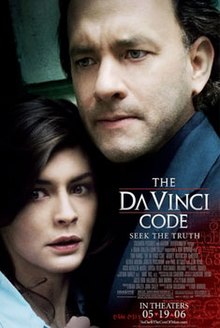
Back The Da Vinci Code (cinta) AN شيفرة دا فينشي (فيلم) Arabic شيفره دا فينشى ARZ Da Vinçi şifrəsi (film) Azerbaijani Da Vinčė kuods BAT-SMG Шифърът на Леонардо (филм) Bulgarian দ্য দা ভিঞ্চি কোড (চলচ্চিত্র) Bengali/Bangla El codi Da Vinci (pel·lícula) Catalan Šifra mistra Leonarda (film) Czech The Da Vinci Code (ffilm) Welsh
| The Da Vinci Code | |
|---|---|
 Theatrical release poster | |
| Directed by | Ron Howard |
| Screenplay by | Akiva Goldsman |
| Based on | The Da Vinci Code by Dan Brown |
| Produced by | |
| Starring | |
| Cinematography | Salvatore Totino |
| Edited by | |
| Music by | Hans Zimmer |
Production companies |
|
| Distributed by | Sony Pictures Releasing (worldwide) Gaumont Columbia TriStar Films (France) |
Release dates |
|
Running time | 149 minutes[1] |
| Countries | United States Malta France United Kingdom |
| Languages | English French Latin Spanish |
| Budget | $125 million[2] |
| Box office | $760 million[2] |
The Da Vinci Code is a 2006 mystery thriller film directed by Ron Howard, written by Akiva Goldsman, and based on Dan Brown's 2003 novel of the same name. The first in the Robert Langdon film series, the film stars Tom Hanks, Audrey Tautou, Ian McKellen, Alfred Molina, Jürgen Prochnow, Jean Reno, and Paul Bettany. In the film, Robert Langdon, a professor of religious symbology from Harvard University, is the prime suspect in the grisly and unusual murder of Louvre curator Jacques Saunière. On the body, the police find a disconcerting cipher and start an investigation.[3] Langdon escapes with the assistance of police cryptologist Sophie Neveu, and they begin a quest for the legendary Holy Grail. Sir Leigh Teabing, a noted British Grail historian, tells them that the actual Holy Grail is explicitly encoded in Leonardo da Vinci's wall painting The Last Supper. Also searching for the Grail is a secret cabal within Opus Dei, an actual prelature of the Holy See, who wish to keep the true Grail a secret to prevent the destruction of Christianity.
The film, like the book, was considered controversial. It was met with especially harsh criticism by the Catholic Church for the accusation that it is behind a two-thousand-year-old cover-up concerning what the Holy Grail really is and the concept that Jesus Christ and Mary Magdalene were married, producing a daughter, as well as its treatment of the organizations Priory of Sion and Opus Dei. Many members urged the laity to boycott the film. In the book, Brown states that the Priory of Sion and "all descriptions of artwork, architecture, documents and secret rituals in this novel are accurate".
The Da Vinci Code premiered as the opening film of the 59th Cannes Film Festival on May 17, 2006, and was theatrically released in the United States on May 19. The film grossed $224 million in its worldwide opening weekend and a total of $760 million worldwide against a $125 million budget, becoming the second-highest-grossing film of 2006, as well as Howard's highest-grossing film to date; however, the film received generally negative reviews from critics. It was followed by two sequels, Angels & Demons (2009) and Inferno (2016).
- ^ "THE DA VINCI CODE (12A)". British Board of Film Classification. Retrieved January 12, 2016.
- ^ a b "The Da Vinci Code". Box Office Mojo. Retrieved September 20, 2020.
- ^ "Dan Brown » The Da Vinci Code". Dan Brown. January 5, 2013. Retrieved April 22, 2016.